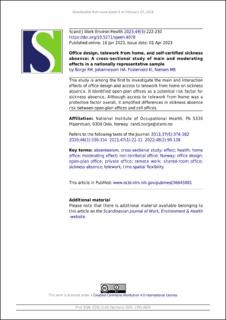| dc.contributor.author | Borge, Randi Hovden | |
| dc.contributor.author | Johannessen, Håkon Andre | |
| dc.contributor.author | Fostervold, Knut Inge | |
| dc.contributor.author | Nielsen, Morten Birkeland | |
| dc.date.accessioned | 2024-02-08T08:40:22Z | |
| dc.date.available | 2024-02-08T08:40:22Z | |
| dc.date.created | 2023-01-17T10:36:09Z | |
| dc.date.issued | 2023 | |
| dc.identifier.citation | Scandinavian Journal of Work, Environment and Health. 2023, 49 (3), 222-230. | |
| dc.identifier.issn | 0355-3140 | |
| dc.identifier.uri | https://hdl.handle.net/11250/3116296 | |
| dc.description.abstract | Objectives This study aimed to investigate (i) the main effects of office design and access to telework from home (TWFH) on self-certified sickness absence and (ii) the moderating effects of access to TWFH on the relationship between office design and self-certified sickness absence. Methods The study used cross-sectional survey data from a nationally representative sample from Norway (N=4329). Research objectives were investigated with negative binomial hurdle models, adjusting for age, gender, education level, leadership responsibility, and time spent on office work. Moderating effects of TWFH were evaluated with pairwise comparisons and plots of estimated marginal means. Results In adjusted models, employees in conventional open-plan offices [odds ratio (OR) 1.32, 95% confidence interval (CI) 1.13–1.54] had significantly higher odds of sickness absence than employees in private offices. Employees with access to TWFH (OR 0.86, 95% CI 0.74–0.99) had significantly lower odds of sickness absence than employees with no access. Among employees with access to TWFH, those in conventional open-plan offices had significantly higher predicted probability of self-certified sickness absence than those in private offices (z=4.41, P<0.0001). There were no significant differences between office designs among employees who did not have access to TWFH. There were no significant main or moderating effects on the number of sickness absence episodes in adjusted models. Conclusions The current study identifies conventional open-plan offices as a potential risk factor for sickness absence. While access to TWFH may be a protective factor overall, it amplified – rather than attenuated – differences in sickness absence between employees in private offices and conventional open-plan offices. | |
| dc.description.abstract | Office design, telework from home, and self-certified sickness absence: A cross-sectional study of main and moderating effects in a nationally representative sample | |
| dc.language.iso | eng | |
| dc.title | Office design, telework from home, and self-certified sickness absence: A cross-sectional study of main and moderating effects in a nationally representative sample | |
| dc.title.alternative | Office design, telework from home, and self-certified sickness absence: A cross-sectional study of main and moderating effects in a nationally representative sample | |
| dc.type | Peer reviewed | |
| dc.type | Journal article | |
| dc.description.version | publishedVersion | |
| dc.source.pagenumber | 222-230 | |
| dc.source.volume | 49 | |
| dc.source.journal | Scandinavian Journal of Work, Environment and Health | |
| dc.source.issue | 3 | |
| dc.identifier.doi | 10.5271/sjweh.4078 | |
| dc.identifier.cristin | 2108344 | |
| cristin.ispublished | true | |
| cristin.fulltext | original | |
| cristin.qualitycode | 1 | |
